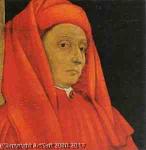Giotto Di Bondone
Giotto Di Bondone
Stil: Proto Renaissance; Gothic Art;
Plass: Near Florence
Født: 1267
Død: 1337
Biografi:
A Life of Innovation and Artistic Revolution
Giotto Di Bondone, the renowned Italian painter and architect, left an indelible mark on the art world with his trailblazing contributions to the Proto-Renaissance and Gothic periods. Born in 1267 in Florence, Italy, Giotto's life remains somewhat shrouded in mystery, yet his artistic legacy is undeniable.
Artistic Contributions and Innovations
Giotto's most celebrated work, the Scrovegni Chapel (or Arena Chapel) in Padua, finished around 1305, is a testament to his innovative spirit. This fresco cycle, depicting the Life of the Virgin and the Life of Christ, not only showcases his artistic genius but also demonstrates a narrative ability that was a significant departure from the stylized Byzantine approach.
- Revolutionizing Painting: Giotto's emphasis on naturalism, attention to human emotion, and exploration of spatial and volumetric figures in painting set the stage for the developments in Western art that followed.
- Architectural Contributions: His commission in 1334 by the Commune of Florence to design the new campanile (bell tower) of the Florence Cathedral affirms his dual talent as both artist and architect.
Notable Works and Their Significance
- Annunciation: The Virgin Receiving the Message (View on Wikioo.org): A prime example of Giotto's Proto-Renaissance style, characterized by its use of naturalism and attention to detail.
- Nativity. Birth of Jesus (View on Wikioo.org): Demonstrates Giotto's ability to convey complex narratives through his frescoes, a hallmark of the Proto-Renaissance period.
- Madonna in Maest (Ognissanti Madonna) (View on Wikioo.org): This altarpiece, commissioned by the Ognissanti Church in Florence, is a significant example of Giotto's panel painting and his use of tempera.
Legacy and Influence
Giotto's influence on Western art is profound, laying the groundwork for the Renaissance art movement. His emphasis on naturalism, human emotion, and spatial awareness in painting has endured, securing his position as a foundational figure in European art history. Explore more of Giotto Di Bondone's works and legacy on Wikioo.org.
Wikipedia link: Click Here














